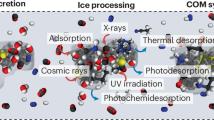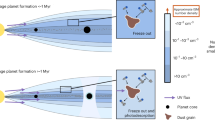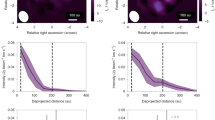Abstract
Organic macromolecular matter is the dominant carrier of volatile elements such as carbon, nitrogen and noble gases in chondrites—the rocky building blocks from which Earth formed. How this macromolecular substance formed in space is unclear. Here we show that its formation could be associated with the presence of dust traps, which are prominent mechanisms for forming planetesimals in planet-forming disks. We demonstrate the existence of heavily irradiated zones in dust traps, where small frozen molecules that coat large quantities of microscopic dust grains could be rapidly converted into macromolecular matter by receiving radiation doses of up to several tens of electronvolts per molecule per year. This allows for the transformation of simple molecules into complex macromolecular matter within several decades. Up to roughly 4% of the total disk ice reservoir can be processed this way and subsequently incorporated into the protoplanetary disk midplane where planetesimals form. This finding shows that planetesimal formation and the production of organic macromolecular matter, which provides the essential elemental building blocks for life, might be linked.
This is a preview of subscription content, access via your institution
Access options
Access Nature and 54 other Nature Portfolio journals
Get Nature+, our best-value online-access subscription
27,99 € / 30 days
cancel any time
Subscribe to this journal
Receive 12 digital issues and online access to articles
118,99 € per year
only 9,92 € per issue
Buy this article
- Purchase on SpringerLink
- Instant access to full article PDF
Prices may be subject to local taxes which are calculated during checkout



Similar content being viewed by others
Data availability
The datasets used and generated during this study are available via Zenodo at https://zenodo.org/records/11953364 (ref. 59).
Code availability
The code used for this study is available via Zenodo at https://zenodo.org/records/11953364 (ref. 59).
References
Marty, B. The origins and concentrations of water, carbon, nitrogen and noble gases on Earth. Earth Planet. Sci. Lett. 313, 56–66 (2012).
Alexander, C. M. O. ’D., Cody, G. D., De Gregorio, B. T., Nittler, L. R. & Stroud, R. M. The nature, origin and modification of insoluble organic matter in chondrites, the major source of Earth’s C and N. Geochemistry 77, 227–256 (2017).
d’Ischia, M. et al. Insoluble organic matter in chondrites: archetypal melanin-like PAH-based multifunctionality at the origin of life? Phys. Life Rev. 37, 65–93 (2021).
Paquette, J. A. et al. D/H in the refractory organics of comet 67P/Churyumov-Gerasimenko measured by Rosetta/COSIMA. Mon. Not. R. Astron. Soc. 504, 4940–4951 (2021).
Walsh, K. J., Morbidelli, A., Raymond, S. N., O’Brien, D. P. & Mandell, A. M. A low mass for Mars from Jupiter’s early gas-driven migration. Nature 475, 206–209 (2011).
Kissel, J. & Krueger, F. R. The organic component in dust from comet Halley as measured by the PUMA mass spectrometer on board Vega 1. Nature 326, 755–760 (1987).
Hayatsu, R., Matsuoka, S., Scott, R. G., Studier, M. H. & Anders, E. Origin of organic matter in the early solar system—VII. The organic polymer in carbonaceous chondrites. Geochim. Cosmochim. Acta 41, 1325–1339 (1977).
Cody, G. D. et al. Establishing a molecular relationship between chondritic and cometary organic solids. Proc. Natl Acad. Sci. USA 108, 19171–19176 (2011).
Robert, F. & Epstein, S. The concentration and isotopic composition of hydrogen, carbon and nitrogen in carbonaceous meteorites. Geochim. Cosmochim. Acta 46, 81–95 (1982).
Laurent, B. et al. The deuterium/hydrogen distribution in chondritic organic matter attests to early ionizing irradiation. Nat. Commun. 6, 8567 (2015).
Alexander, C. M. O’D., Boss, A. P., Keller, L. P., Nuth, J. A. & Weinberger, A. Astronomical and meteoritic evidence for the nature of interstellar dust and its processing in protoplanetary disks. in Protostars and Planets V (eds Reipurth, B., Jewitt, D. & Keil, K.) 801–813 (University of Arizona Press, 2007).
Binet, L., Gourier, D., Derenne, S. & Robert, F. Heterogeneous distribution of paramagnetic radicals in insoluble organic matter from the Orgueil and Murchison meteorites. Geochim. Cosmochim. Acta 66, 4177–4186 (2002).
Alexander, C. M. O. ’D., Nilges, M. J., Cody, G. D. & Herd, C. D. K. Are radicals responsible for the variable deuterium enrichments in chondritic insoluble organic material? Geochim. Cosmochim. Acta https://doi.org/10.1016/j.gca.2021.10.007 (2022).
Laurent, B. et al. Isotopic and structural signature of experimentally irradiated organic matter. Geochim. Cosmochim. Acta 142, 522–534 (2014).
Ott, U. Planetary and pre-solar noble gases in meteorites. Geochemistry 74, 519–544 (2014).
Strazzulla, G. & Baratta, G. A. Carbonaceous material by ion irradiation in space. Astron. Astrophys. 266, 434–438 (1992).
Ferini, G., Baratta, G. A. & Palumbo, M. E. A Raman study of ion irradiated icy mixtures. Astron. Astrophys. 414, 757–766 (2004).
Palumbo, M. E., Ferini, G. & Baratta, G. A. Infrared and Raman spectroscopies of refractory residues left over after ion irradiation of nitrogen-bearing icy mixtures. Adv. Space Res. 33, 49–56 (2004).
Danger, G. et al. The transition from soluble to insoluble organic matter in interstellar ice analogs and meteorites. Astron. Astrophys. 667, A120 (2022).
Shen, C. J., Greenberg, J. M., Schutte, W. A. & Van Dishoeck, E. F. Cosmic ray induced explosive chemical desorption in dense clouds. Astron. Astrophys. 415, 203–215 (2004).
Ciesla, F. J. & Sandford, S. A. Organic synthesis via irradiation and warming of ice grains in the solar nebula. Science 336, 452–454 (2012).
van der Marel, N. et al. A major asymmetric dust trap in a transition disk. Science 340, 1199–1202 (2013).
Andrews, S. M. Observations of protoplanetary disk structures. Annu. Rev. Astron. Astrophys. 58, 483–528 (2020).
Pinilla, P. et al. Trapping dust particles in the outer regions of protoplanetary disks. Astron. Astrophys. 538, A114 (2012).
Youdin, A. N. & Goodman, J. Streaming instabilities in protoplanetary disks. Astrophys. J. 620, 459 (2005).
Izidoro, A. et al. Planetesimal rings as the cause of the Solar System’s planetary architecture. Nat. Astron. 6, 357–366 (2022).
Hellmann, J. L. et al. Origin of isotopic diversity among carbonaceous chondrites. Astrophys. J. Lett. 946, L34 (2023).
Booth, A. S. et al. An inherited complex organic molecule reservoir in a warm planet-hosting disk. Nat. Astron. 5, 684–690 (2021).
van Der Marel, N., Booth, A. S., Leemker, M., van Dishoeck, E. F. & Ohashi, S. A major asymmetric ice trap in a planet-forming disk-I. Formaldehyde and methanol. Astron. Astrophys. 651, L5 (2021).
Brunken, N. G. C. et al. A major asymmetric ice trap in a planet-forming disk-III. First detection of dimethyl ether. Astron. Astrophys. 659, A29 (2022).
Booth, A. S. et al. Sulphur monoxide emission tracing an embedded planet in the HD 100546 protoplanetary disk. Astron. Astrophys. 669, A53 (2023).
van der Marel, N. Transition disks: the observational revolution from SEDs to imaging. Eur. Phys. J. Plus 138, 225 (2023).
Pinilla, P., Lenz, C. T. & Stammler, S. M. Growing and trapping pebbles with fragile collisions of particles in protoplanetary disks. Astron. Astrophys. 645, A70 (2021).
Boogert, A. C. A., Gerakines, P. A. & Whittet, D. C. B. Observations of the icy universe. Annu. Rev. Astron. Astrophys. 53, 541–581 (2015).
Bruderer, S. Survival of molecular gas in cavities of transition disks-I. CO. Astron. Astrophys. 559, A46 (2013).
Cevallos Soto, A., Tan, J. C., Hu, X., Hsu, C.-J. & Walsh, C. Inside-out planet formation–VII. Astrochemical models of protoplanetary discs and implications for planetary compositions. Mon. Not. R. Astron. Soc. 517, 2285–2308 (2022).
Potapov, A., Fulvio, D., Krasnokutski, S., Jäger, C. & Henning, T. Formation of complex organic and prebiotic molecules in H2O:NH3:CO2 ices at temperatures relevant to hot cores, protostellar envelopes, and planet-forming disks. J. Phys. Chem. A 126, 1627–1639 (2022).
Ligterink, N. F. W. et al. Controlling the emission profile of an H2 discharge lamp to simulate interstellar radiation fields. Astron. Astrophys. 584, A56 (2015).
Bacmann, A. et al. CO depletion and deuterium fractionation in prestellar cores. Astrophys. J. 585, L55 (2003).
Spezzano, S., Caselli, P., Sipilä, O. & Bizzocchi, L. Nitrogen fractionation towards a pre-stellar core traces isotope-selective photodissociation. Astron. Astrophys. 664, L2 (2022).
Almayrac, M. G. et al. The EXCITING experiment exploring the behavior of nitrogen and noble gases in interstellar ice analogs. Planet. Sci. J. 3, 252 (2022).
Sandford, S. A., Nuevo, M., Bera, P. P. & Lee, T. J. Prebiotic astrochemistry and the formation of molecules of astrobiological interest in interstellar clouds and protostellar disks. Chem. Rev. 120, 4616–4659 (2020).
Qasim, D. et al. Alcohols on the rocks: solid-state formation in a H3CC CH + OH cocktail under dark cloud conditions. ACS Earth Space Chem. 3, 986–999 (2019).
Raut, U., Fulvio, D., Loeffler, M. J. & Baragiola, R. A. Radiation synthesis of carbon dioxide in ice-coated carbon: implications for interstellar grains and icy moons. Astrophys. J. 752, 159 (2012).
Qasim, D. et al. Meteorite parent body aqueous alteration simulations of interstellar residue analogs. ACS Earth Space Chem. 7, 156–167 (2023).
Sandford, S. A., Bernstein, M. P. & Swindle, T. D. The trapping of noble gases by the irradiation and warming of interstellar ice analogs. Meteorit. Planet. Sci. 33, A135 (1998).
Sridhar, S., Bryson, J. F. J., King, A. J. & Harrison, R. J. Constraints on the ice composition of carbonaceous chondrites from their magnetic mineralogy. Earth Planet. Sci. Lett. 576, 117243 (2021).
Yabuta, H. et al. Macromolecular organic matter in samples of the asteroid (162173) Ryugu. Science 379, eabn9057 (2023).
Blum, J., Bischoff, D. & Gundlach, B. Formation of comets. Universe 8, 381–415 (2022).
Busemann, H. et al. Interstellar chemistry recorded in organic matter from primitive meteorites. Science 312, 727–730 (2006).
Binkert, F. & Birnstiel, T. Carbon depletion in the early Solar System. Mon. Not. R. Astron. Soc. 520, 2055–2080 (2023).
De Gregorio, B. T. et al. Isotopic and chemical variation of organic nanoglobules in primitive meteorites. Meteorit. Planet. Sci. 48, 904–928 (2013).
Nakamura-Messenger, K., Messenger, S., Keller, L. P., Clemett, S. J. & Zolensky, M. E. Organic globules in the Tagish Lake meteorite: remnants of the protosolar disk. Science 314, 1439–1442 (2006).
Muñoz-Caro, G. M. et al. Comparison of UV and high-energy ion irradiation of methanol: ammonia ice. Astron. Astrophys. 566, A93 (2014).
Stammler, S. M. & Birnstiel, T. DustPy: a Python package for dust evolution in protoplanetary disks. Astrophys. J. 935, 35 (2022).
Dullemond, C. P. et al. RADMC-3D: a multi-purpose radiative transfer tool. Astrophysics Source Code Library http://ascl.net/1202.015 (2012).
Cruz-Diaz, G. A., Muñoz-Caro, G. M., Chen, Y.-J. & Yih, T.-S. Vacuum-UV spectroscopy of interstellar ice analogs-I. Absorption cross-sections of polar-ice molecules. Astron. Astrophys. 562, A119 (2014).
Birnstiel, T., Fang, M. & Johansen, A. Dust evolution and the formation of planetesimals. Space Sci. Rev. 205, 41–75 (2016).
Ligterink, N. Dust_trap_radiation_model. Zenodo https://zenodo.org/records/11953364 (2024).
Acknowledgements
We thank E. G. Bøgelund and M. N. Drozdovskaya for insightful discussions. N.F.W.L. is supported by the Swiss National Science Foundation (SNSF) Ambizione Grant 193453. P.P. acknowledges the support from the UK Research and Innovation (UKRI) under the UK government’s Horizon Europe funding guarantee from ERC (under grant agreement no. 101076489). A.S.B. is supported by a Clay Postdoctoral Fellowship from the Smithsonian Astrophysical Observatory. M.E.I.R. is supported by the SNSF Ambizione Grant 193331.
Author information
Authors and Affiliations
Contributions
N.F.W.L. developed the model with support from P.P. Analysis and interpretation of the model results were performed by N.F.W.L., P.P., N.v.d.M., J.T.v.S., A.S.B., C.M.O’D.A. and M.E.I.R. All authors contributed to writing and review of the paper.
Corresponding author
Ethics declarations
Competing interests
The authors declare no competing interests.
Peer review
Peer review information
Nature Astronomy thanks Martin Cordiner, Joanna Drążkowska and the other, anonymous, reviewer(s) for their contribution to the peer review of this work.
Additional information
Publisher’s note Springer Nature remains neutral with regard to jurisdictional claims in published maps and institutional affiliations.
Extended data
Extended Data Fig. 1 Dust density distribution for grains of 0.1, 1, 10, and 100 μm in size.
The black dashed lines indicate the total dust density distribution contours at 10−19 and 10–16 g cm−3.
Extended Data Fig. 2 Dust temperatures for grains of 0.1, 1, 10, and 100 μm in size.
The white dashed lines indicate the 100 K temperature contour, while the black dashed lines indicate the total dust density distribution contours at 10−19 and 10−16 g cm−3.
Rights and permissions
Springer Nature or its licensor (e.g. a society or other partner) holds exclusive rights to this article under a publishing agreement with the author(s) or other rightsholder(s); author self-archiving of the accepted manuscript version of this article is solely governed by the terms of such publishing agreement and applicable law.
About this article
Cite this article
Ligterink, N.F.W., Pinilla, P., van der Marel, N. et al. The rapid formation of macromolecules in irradiated ice of protoplanetary disk dust traps. Nat Astron 8, 1257–1263 (2024). https://doi.org/10.1038/s41550-024-02334-4
Received:
Accepted:
Published:
Issue Date:
DOI: https://doi.org/10.1038/s41550-024-02334-4



